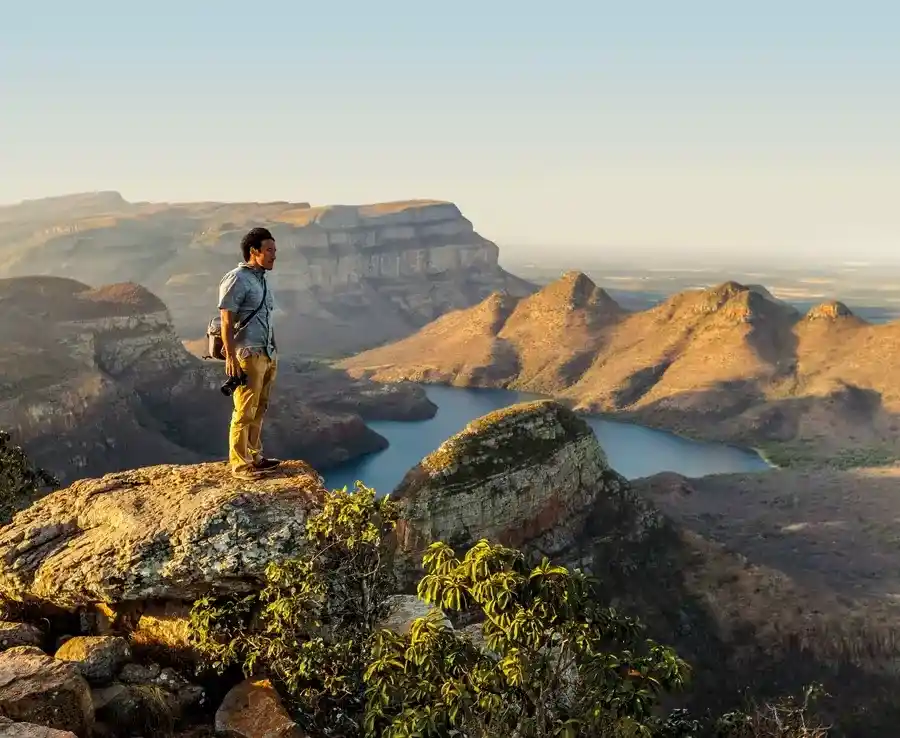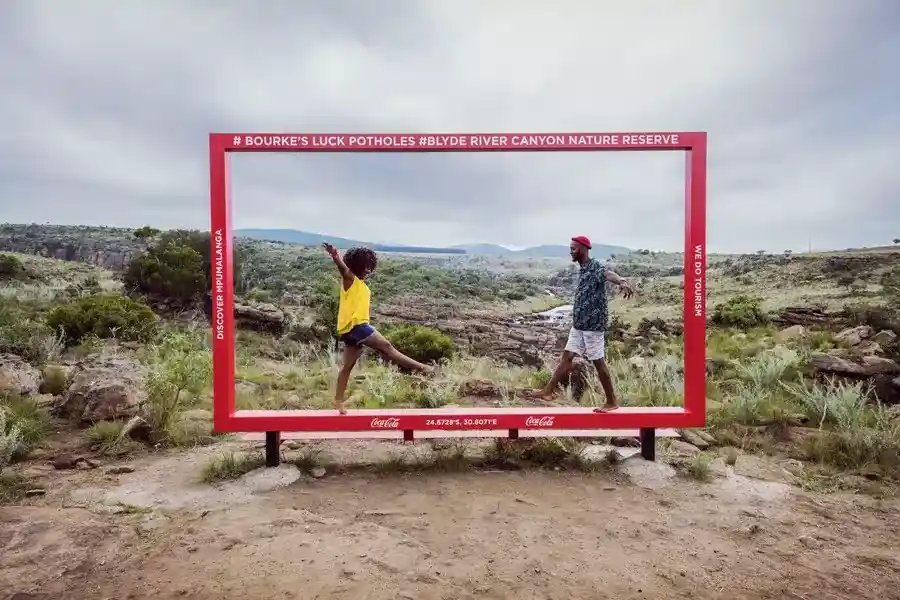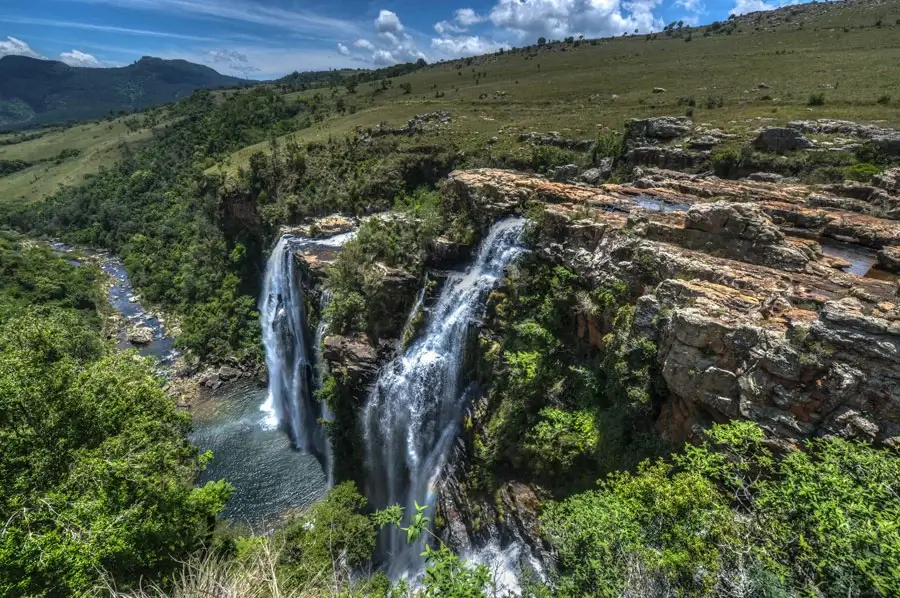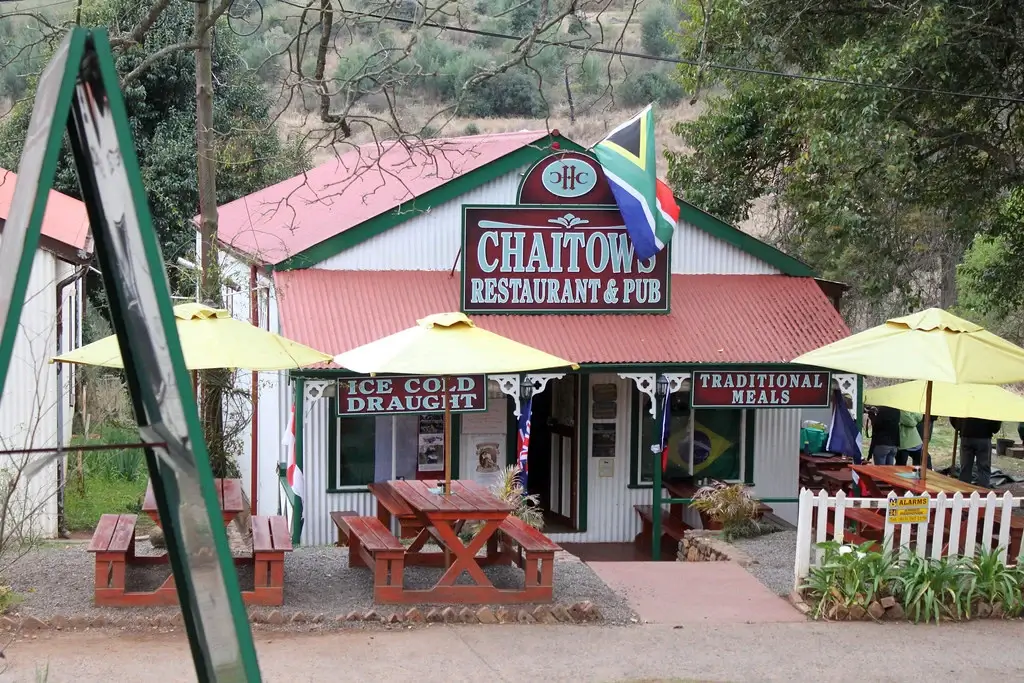One of the country's most scenic self-drives, the Panorama Route, explores the Mpumalanga highlands, or the north-eastern section of the Great Escarpment of the Drakensberg. The Panorama Route's popularity has much to do with its proximity to the Kruger National Park. It is often part and parcel of any organised trip to the game reserve and, it is also favoured for the access it provides to one of the province's major scenic attractions, the Blyde River Canyon, which is one of the largest canyons on earth, and increasingly popular with overseas visitors.
It features numerous waterfalls, one of the largest afforested areas in South Africa and several natural landmarks. The route starts at the foot of the Long Tom Pass just outside Lydenberg, following the natural descent from the Great Escarpment to the Lowveld, and ending at the border of the Mpumalanga and Limpopo provinces near the echo caves.
Some History
From 1871, parts of the route were used as a transport road between Lydenberg and Delagoa Bay. It is also on this route that General Louis Botha fled from the English during the Anglo Boer War and houses one of the most famous Victorian-age canons in the world, The Long Tom.
During the Transvaal gold rush in the late 1800s, many towns on the route were established. Thousands of fortune seekers crossed the treacherous mountains and rugged terrain in the search of gold. One of these was a former storekeeper from Pilgrim's Rest, Percy Fitzpatrick. Writer of the famous story Jock of the Bushveld where he recounts some of the adventures he shared with his brave bull terrier Jock, whilst traversing this famous route.
Major Attractions
Blyde River Canyon
Beginning from the small town of Graskop on the R532, this famous route is home to mountains, forests and canyons, and most notably, the Blyde River Canyon, which is the world’s largest green canyon. The canyon is named for the river that runs through it, the Blyde River, now called Motlatse River and is 26km long, forming part of the Blyde River Canyon Nature Reserve. The scenery of the 25 000ha reserve is unsurpassed, its vegetation both varied and lush with a rich selection of bird life. From many well-positioned vantage points, one has a view of the 33 km long gorge.
Wildlife in the canyon area is as varied as the habitats. There is mountain reedbuck on the escarpment, dassies on the canyon walls, hippo and crocodile in the Blyde Dam, and impala, kudu, blue wildebeest, waterbuck and zebra on the Lowveld plain near the canyon's mouth.

Gods Window
God’s Window is one of the Blyde River Canyon Nature Reserve’s most spectacular viewpoints, with astonishing views over South Africa’s Lowveld. It’s so named because it is much lower than the high escarpment along which the Panorama Route runs, and it’s likened to the garden of Eden in the Hebrew bible. At God’s Window, majestic cliffs plunge down 700m and, on a clear day, you'll be able to see over the famous Kruger National Park towards the Lebombo Mountains on South Africa’s border with Mozambique. One of the scenes of the 1980s film, the God’s must be crazy, was filmed in Gods Window.

Bourke’s Luck Potholes
Bourke’s Luck Potholes are rock formations formed by erosion centuries ago. You must take a walk on paths and bridges of about 700 meters to see this natural wishing well.
The bizarre cylindrical holes were created through millions of years of water flow, in rapid circular movements, arising from the confluence of the Treur and Blyde rivers. The swirling water, along with sand and pebbles, sharpened the rocks and created a beautiful natural work of art. The ravine in which these holes lie is 30 meters deep, but the holes themselves are around 6 meters deep. Due to the soil present in the water each hole appears as a different hue of yellow, brown or white.
The area is named after Tom Bourke, who ironically never had any luck when he was looking for gold here but predicted that large amounts of gold would be found in this area.

The Three Rondavels
Once known as the Three Sisters, the geological formations known today as The Three Rondavels, are one of the many natural highlights along Mpumalanga's Panorama Route. People know the rondavel as a traditional beehive shaped hut. The Three Rondavels are spectacular peaks which look exactly like rondavels which are round and fat, rising to a peaked top, but much, much higher than any traditional dwelling. In fact, when you stand on the viewpoint, 1 380m above sea level with the Blyde River Canyon below, you'll still be looking up at those three distinctive peaks which tower 700m above the surrounding countryside. These amazing mountains were formed by erosion which wore away the soft underlying stone, leaving exposed slate and quartzite that shape these dramatic rock formations.
Lisbon Falls
The Lisbon Falls are situated in the heart of the waterfall area of Mpumalanga, where the number of these dramatic falls exceeds that of anywhere else in southern Africa. Lisbon Falls is 94 metres, or 308 feet, high, which makes it one of the highest in the province.

Berlin Falls
Shaped like a huge white candle, the falls flow through a natural sluice before cascading down into a deep pool. It’s a great place for a swim followed by a picnic. The Berlin Falls are among a cluster of Sabie waterfalls comprising the Horseshoe, Lone Creek and Bridal Veil Falls, the Mac Mac Falls and Mpumalanga’s highest waterfall: the 90m Lisbon Falls. The water pours through a natural sluice in the rock, plunges straight down for a few meters (this is the candle wick), then widens into a broad torrent which falls in a straight line down to the pool (the candle itself).
Some Historical Towns to Visit
Pilgrims Rest
The most famous town in the region is Pilgrims’ Rest, now something of a living museum and tribute to the gold-panning days of the late 1800s. When you visit, you'll step straight back into the pages of the past. Pilgrim’s Rest is a small town with a very colourful and exciting history. In 1873 the town and surrounding area was densely populated with prospectors all hoping to make their fortunes in the second of the Transvaal gold fields.
Today the town is a tourist location that takes visitors back in time to the days of the gold rush in the 1870’s. When it first became a tourist attraction in 1970 it was changed very little from its heyday and is now a protected historical site. In 1986 the town was declared a National Monument and since then a concerted effort has been made by curators, historians, architects and other interested parties to ensure the integrity of its history is always preserved.
It has been said that there is still gold in the ground, which is exciting for visitors to contemplate as they stand on the very site where 150 years earlier men, women and children were frantically digging and panning for the elusive solid nuggets that would make them instantly rich beyond their wildest dreams. The scars of the frantic digging for gold by many prospectors are still obvious despite the passage of time and are just a part of what makes the town unique and interesting.

Lydenberg
Lying only 290kms from Pretoria, Lydenburg is an easy 3-hour drive from Gauteng making it an ideal springboard to the world-renowned attractions on the Panorama Route. Four steams traverse the area, namely the Dorps River, Sterkspruit, Doringspruit and Klipgat, making fly fishing a very popular sport in the region, with great fishing opportunities.
Lydenburg is the home of numerous iron age sites such as on the Boomplaas farm and replicas of the Lydenburg Heads are beautifully displayed in the Lydenburg Museum along with much of the original pottery. The Museum is also a treasure-house of early settler and Anglo Boer War displays.

Graskop
Set up in the 1880s as a gold mining camp, it now serves as a wonderful tourism destination and serves the Timber industry. Graskop is 14km south-east of Pilgrims Rest and 28km north of Sabie. It’s a small forestry town renowned for its pancake bars and curio shops. The little towns history can be traced back to 1837, when the Voortrekker leader, Andries Pretorius and his followers, were looking for greener pastures.
Some unique activities to try out when visiting are the Graskop Gorge Lift where you drop off the grassy cliff top in a custom-designed 26 passenger viewing elevator which travels 51 metres down the cliff face into the mountain forests below. A network of walkways, suspension bridges and interactive exhibits lead you along the 500 metre forest trails and across the streams. Nearby, there’s also a silk farm where they process silk from silk worms such as the Mulberry Silk Caterpillar. If you love your morning coffee, you can take an educational guided tour of the nearby Austrian Coffee Estate.
Sabie
A small country town nestled in a deep valley on the escarpment of the Drakensberg Mountain range. It is known for its scenery and beautiful waterfalls. There are all sorts of activities to enjoy such as river-tubing, caving by candlelight, bridge swinging, abseiling, mountain biking, hiking and more.
There’s so much to see and experience on this scenic adventure called the Panorama Route and so much to do for all types of travellers. If you love breath-taking views and extraordinary sights, or even history, the Panorama Route is definitely worth exploring.
